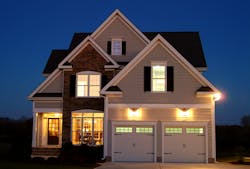While many homeowners recognize the importance of security and surveillance systems to monitor their homes and protect their loved ones, there is one value-added security feature that remains massively underutilized: connected security lighting.
This is due, in part, to a lack of homeowner education. Lighting integration increases safety, proactively deters intruders, improves video capture quality and can present a lived-in feel even when the home is empty. It is our job as security system providers to make sure homeowners understand the full scope of benefits modern solutions can provide.
Proactive vs. Reactive Security
Ever since the first window sensors and alarms began foiling criminals in the act, homeowners have largely viewed security systems as reactive solutions that take action only after a crime has been committed, sounding alarms and contacting law enforcement. Lighting, on the other hand, is a proactive security solution because it can actually prevent an intrusion or incident from occurring. There are two main proactive effects of security lighting: presenting a lived-in appearance and lighting exterior areas to expose trespassers. With the ability to connect both interior and exterior light fixtures and set daily schedules for each one, security lighting solutions make homes look convincingly occupied when no one is home – an idea we call “mockupancy.” It is incredible how effective it can be to make sure a porch light and one or two interior lights are on, especially if they are set to change to look as though people are walking through the home.
Exterior security lighting with motion sensors may be even more impactful, as it can scare off potential criminals and greatly improve the quality of surveillance recordings. In the case of a theft or break-in, a standard response is for both interior and exterior lights to turn on or flash on and off, alerting neighbors and clearly identifying the house for responding officers. Having the exterior lights turn on also ensures the clearest possible video recordings to help law enforcement identify and apprehend suspects.
Hands-On vs. Hands-Off
The best-case scenario for a homeowner is that they never have to do anything more than arm and disarm their security system and can effectively pretend it is not even there. However, this hands-off approach to security can also prevent homeowners from thinking about their professional integrator and considering other ways their home technology can be improved.
Lighting is perhaps the most hands-on system in a home, with individuals using dozens of light switches or fixtures every day; in fact, lighting is a major part of the minute-to-minute experience in a home, and integrating lighting with a security system introduces a daily reminder of how disparate home systems can work together to improve home living.
This keeps the integrator, at the top of customers’ minds. Once they have connected lighting, they can begin to experiment with lighting scenes and schedules to simplify daily home life and even save energy, which can lead to interest in more advanced home systems and capabilities.
Add Value by Adding Integrated Lighting Features
The facts are clear that lighting functions improve the effectiveness of security and surveillance systems, and it is important for customers to know these added features do not cost an arm and a leg or require replacing existing equipment. The best solution is one that is easy to deploy and operate and does not use specialty wiring.
Many systems are compatible with Z-wave devices, which can communicate with Z-wave light switches and make them part of the security system events.
There are plenty of options for interested customers, from add-ons to smart lighting systems to full home control and automation solutions. With so many products to choose from, there is a security and lighting solution for nearly any budget, and integrators can create custom packages to fit any need.
Selling a customer on a lighting upgrade – whether up-front or for a retrofit project – can be as simple as telling them their cameras will look better at night or their lights will come on automatically when they drive up the driveway, which are lifestyle benefits that extend beyond security. For homeowners exclusively concerned about security, the strongest argument is the major increase in criminal deterrence that connected lighting and ‘mockupancy’ schedules can provide.
Be Expandable, Not Expendable
A core expectation of modern installations is that owners will want to expand the solution down the line, so it is crucial to use products that allow for future expansion and multi-system integration. This not only keeps the client interested and attentive to how their home electronic systems can be more useful, it also shows them that you are looking out for their long-term safety and happiness, and not just trying to sell a one-and-done project. The last thing an integrator wants is a customer to forget about them.
Every homeowner can benefit from integrated security lighting, so security integrators who want to grow their business must stay up-to-date on the latest technologies and capabilities in order to convince customers how these powerful benefits can improve their home lives.
Clint Choate is Senior Director for the security market at Snap One. Learn more about the company and request more info at www.securityinfowatch.com/21090092.



